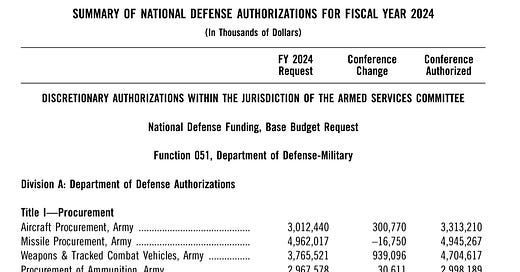Let’s pick up where we left off yesterday and dig a little more in to the NDAA.
Where is the money going, and what does that tell us? What comes out of conference, imperfectly, can tell you what is worth selling and what is worth buying.
Overall, more money came out of conference than coming it. As a guy who likes to repeat, “we are a maritime and aerospace power” I’m nodd’n my head in agreement to the Top-5 big spends;
Shipbuilding and Conversion: $33 billion
Other Procurement, Air Force: $30 billion
Aircraft Procurement, Air Force: $20 billion
Aircraft Procurement, Navy: $17 billion
Other Procurement, Navy: $15 billion
Interesting details is who left the conference with less money than going in - especially in the case of these two as a percentage of their total;
Aircraft Procurement, Air Force: -$665 million
Procurement, Space Force: -$528 million
Three standouts on where that money went;
Weapons and Tracked Combat Vehicles, Army: $939 million
Aircraft Procurement, Navy: $672 million
That Army uplift is almost a 25% increase. My bet is I have to think that is related to backfilling what was sent to Ukraine and reactions to the lessons we’re learning. Sure, I’m just being realistic on the former and optimistic on the later - but I’ll make that bet.
You can see that shadow again in Title III - Operation and Maintenance;
We need to ask John Konrad about the significant plus up to the Maritime Administration Title XXXV line;
There are the big pixel items. Navalists can’t be too grumpy. Sure, I’d change a few things, but I’m not emperor yet - so - I’ll take it.
Of course, the devil is in the details. If want to fight about them, go to page 2,888 and fight it out in comments.
We’ll visit the NDAA a third time on Thursday.
Yes, Thursday.







CDR Salamander has provided us with an invaluable service with his analysis.
The budget is ground truth. It is almost a solemn moment in DC when the SECDEF, CJCS and Comptroller appear before the SASC.
As we can see the budget is a mixed bag and many here have pointed out its various shortcomings.
My concern is the underlying thinking behind the budget.
We do not have the necessary industrial base or financial resources necessary to fulfill our commitments if a lot bad things happened simultaneously around the world.
Our leadership - which does not fill me with confidence - would have to start making hard choices between guns and butter as Lyndon Johnson was forced to do.
The main reason we were a global power is we understood the importance of logistical infrastructure from a global perspective. You can't project air without airfields that can support your aircraft, otherwise they land and become expensive static displays. You can't project your maritime forces without suitable logistics and (at times) repair facilities to support maritime movement and sustain operations beyond their internal fuel and munitions. That infrastructure requires its own support structure to make it possible. No one else could do it the way we could.
Sadly, we have seen a major degradation in our front line capabilities as aircraft and ship availability decline due to shrinking numbers, poor maintenance and supply issues (which impact training and operations). Force projection capability has also significantly declined as the all important global infrastructure has degraded due to lack of funding and expertise aging out.
The one thing that doesn't seem in short supply is our delusional mindset that we are as capable as we were twenty years ago. Hubris may not be the right word, but it will have to do for now.